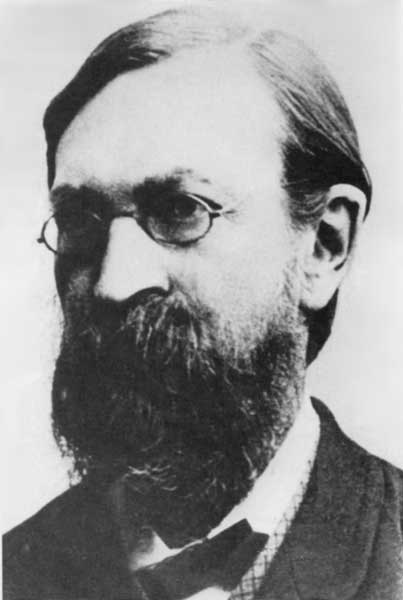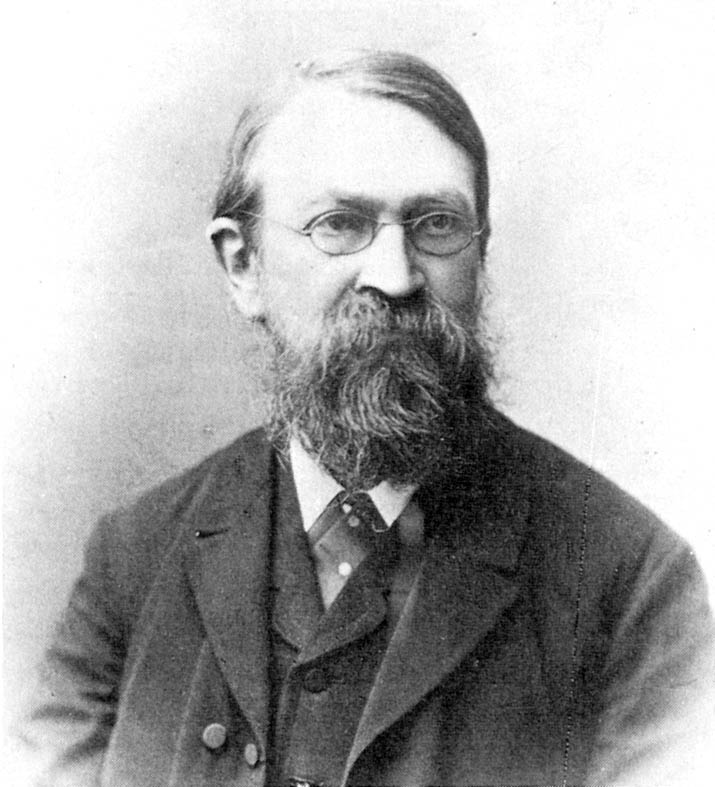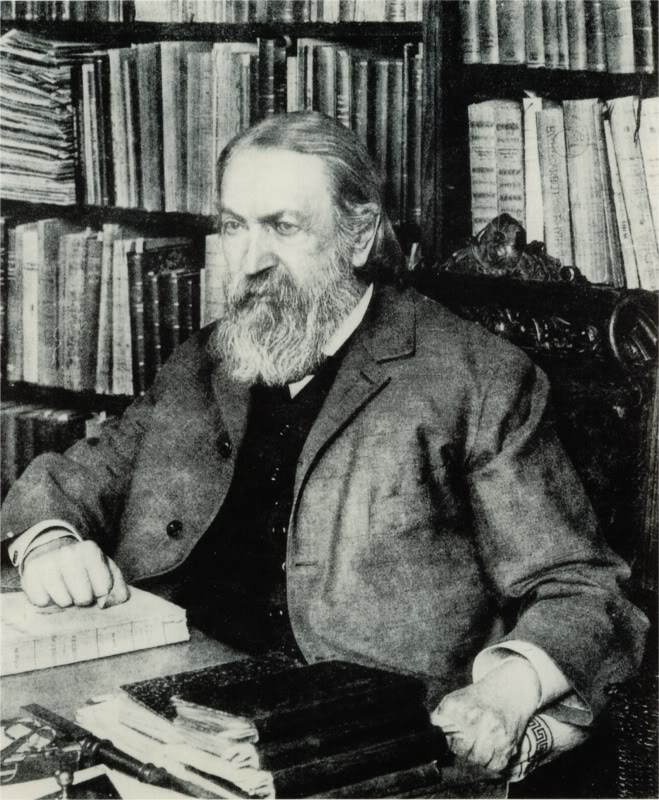<Back to Index>
- Physicist and Philosopher Ernst Mach, 1838
- Architect and Polymath Leon Battista Alberti, 1404
- Chairman of the Presidium of the Supreme Soviet Nikolai Viktorovich Podgorny, 1903
PAGE SPONSOR


Ernst Mach (February 18, 1838 – February 19, 1916) was an Austrian physicist and philosopher, remembered for his contributions to physics such as the Mach number and the study of shock waves. As a philosopher of science, he was a major influence on logical positivism and through his criticism of Newton, a forerunner of Einstein's relativity.
Ernst Mach was born in Chirlitz, in the Austrian empire (now Chrlice, part of Brno in the Czech Republic). His father, who had graduated from Prague University, acted as tutor to the noble Brethon family in Zlín, eastern Moravia. Some sources give Mach's birthplace as Turas/Tuřany (now also part of Brno), the site of the Chirlitz registry office. Peregrin Weiss baptized Ernst Mach into the Roman Catholic Church in Turas/Tuřany.
Up to the age of 14 Mach received his education at home from his parents. He then entered a Gymnasium in Kremsier (now Kroměříž), where he studied for three years. In 1855 he became a student at the University of Vienna. There he studied physics and for one semester medical physiology, receiving his doctorate in physics in 1860 and his Habilitation the following year. His early work focused on the Doppler effect in optics and acoustics. In 1864 he took a job as Professor of Mathematics in Graz, having turned down the position of a chair in surgery at the University of Salzburg to do so, and in 1866 he was appointed as Professor of Physics. During that period Mach continued his work in psycho-physics and in sensory perception. In 1867 he took the chair of Professor of Experimental Physics at Charles-Ferdinand University, Prague, where he stayed for 28 years.
Mach's main contribution to physics involved his description and photographs of spark shock waves and then ballistic shock waves. He described how passing the sound barrier caused the compression of air in front of bullets and shells. Using a so-called "schlierenmethode" he and his son Ludwig were able to photograph the shadows of the invisible shock waves. During the early 1890s Ludwig was able to invent an interferometer which allowed for much clearer photographs. But Mach also made many contributions to psychology and physiology including his anticipation of gestalt phenomena, his discovery of Mach bands, an inhibition-influenced type of visual illusion, and especially his discovery of a non-acoustic function of the inner ear which helped control human balance.
Mach also became well-known for his philosophy, a type of phenomenalism recognizing only sensations as real. This position seemed incompatible with the view of atoms and molecules as external, mind-independent things, and from about 1908 to 1911 Mach's reluctance to acknowledge the reality of atoms was criticized by Max Planck as being incompatible with physics. Some of Mach's criticisms of Newton's position on space and time influenced Einstein, but later Einstein realized that Mach was basically opposed to Newton's philosophy and concluded that his physical criticism was not sound. One of the best known of Mach's ideas is the so-called "Mach's principle," concerning the physical origin of inertia. This was never written down by Mach, but was given a graphic verbal form, attributed by Philipp Frank to Mach himself, as, "When the subway jerks, it's the fixed stars that throw you down." In this form its incompatibility with Einstein's conviction of the universal retardation of distant action is apparent. As an experimental physicist Mach tended to think that scientific theories were only provisional and had no lasting place in physics. This attitude made it hard for him to accept Einstein's special theory of relativity, especially since the second axiom seemed like an absolute of the kind Mach opposed, which was criticized in the preface to a posthumously published book on light which appeared in 1921.
In 1898 Mach suffered from cardiac arrest and in 1901 retired from the University of Vienna and was appointed to the upper chamber of the Austrian parliament. On leaving Vienna in 1913 he moved to his son's home in Vaterstetten, near Munich, where he continued writing and corresponding until his death in 1916.
Most of Mach's initial studies in the field of experimental physics concentrated on the interference, diffraction, polarization and refraction of light in different media under external influences. There followed his important explorations in the field of supersonic velocity. Mach's paper on this subject was published in 1877 and correctly
describes the sound effects observed during the supersonic motion of a projectile. Mach deduced and experimentally confirmed the existence of a shock wave which has the form of a cone with the projectile at the apex. The ratio of the speed of projectile to the speed of sound vp/vs is now called the Mach number. It plays a crucial role in aerodynamics and hydrodynamics. He also contributed to cosmology the hypothesis known as Mach's principle. Mach developed a philosophy of science which became influential in the 19th and 20th centuries.
He saw scientific laws as summaries of experimental events, constructed
for the purpose of making complex data comprehensible. Thus scientific
laws have more to do with describing sensations than with reality as it
exists beyond sensations. In accordance with this philosophy, Mach opposed Ludwig Boltzmann and others who proposed an atomic theory of
physics. Since one cannot observe things as small as atoms directly,
and since no atomic model at the time was consistent, the atomic
hypothesis seemed to Mach to be unwarranted, and perhaps not
sufficiently "economical". Mach had a direct influence on the Vienna Circle philosophers and the school of logical positivism in general. Albert Einstein in 1930 stated that "it is justified to consider Mach as the precursor of the general theory of relativity", though Mach, before his death, would reject Einstein's theory. Mach's positivism also influenced many Russian Marxists, such as Alexander Bogdanov (1873 – 1928). In 1908, Lenin wrote a philosophical work, Materialism and Empirio-Criticism (published 1909), in which he criticized Machism and the views of "Russian Machists".
In 1873, independently of each other Mach and the physiologist and physician Josef Breuer discovered
how the sense of balance (i.e., the perception of the head’s imbalance)
functions, tracing its management by information which the brain
receives from the movement of a fluid in the semicircular canals of the inner ear. That the sense of balance depended on the three semicircular canals was discovered in 1870 by the physiologist Friedrich Goltz, but Goltz didn't discover how the balance-sensing apparatus functioned. In the area of sensory perception, psychologists remember Mach for the optical illusion called the Mach band. Mach's views on mediating structures inspired B.F. Skinner's strongly inductive position, which paralleled Mach's in the field of psychology.
The lunar crater Mach takes its name from Ernst Mach.

